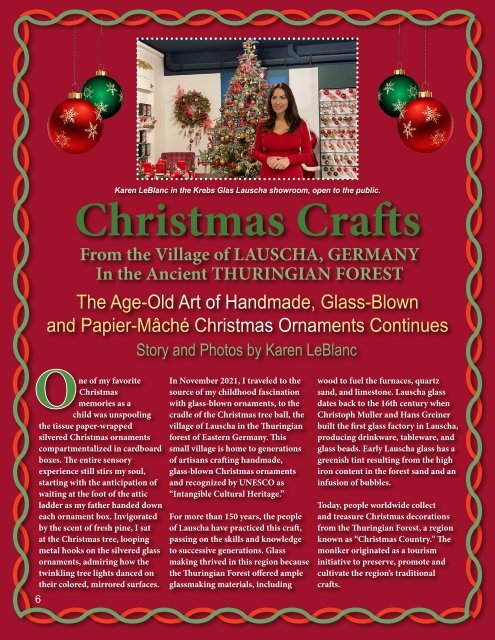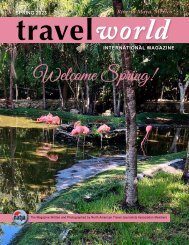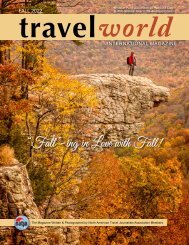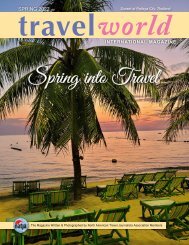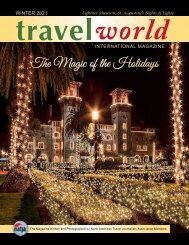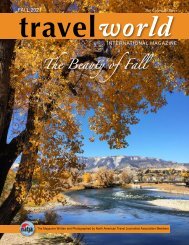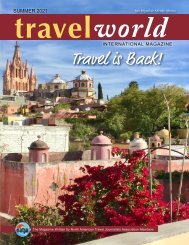TravelWorld International Magazine Winter 2022
The magazine written and photographed by North American Travel Journalist Association members
The magazine written and photographed by North American Travel Journalist Association members
Create successful ePaper yourself
Turn your PDF publications into a flip-book with our unique Google optimized e-Paper software.
Karen admiring more than 5,000<br />
different styles of glass Christmas<br />
ornaments on display in the<br />
Krebs Glas Lauscha showroom.<br />
Karen LeBlanc in the Krebs Glas Lauscha showroom, open to the public.<br />
Christmas Crafts<br />
From the Village of LAUSCHA, GERMANY<br />
In the Ancient THURINGIAN FOREST<br />
The Age-Old Art of Handmade, Glass-Blown<br />
and Papier-Mâché Christmas Ornaments Continues<br />
Story and Photos by Karen LeBlanc<br />
ne of my favorite<br />
Christmas<br />
memories as a<br />
child was unspooling<br />
the tissue paper-wrapped<br />
silvered Christmas ornaments<br />
compartmentalized in cardboard<br />
boxes. The entire sensory<br />
experience still stirs my soul,<br />
starting with the anticipation of<br />
waiting at the foot of the attic<br />
ladder as my father handed down<br />
each ornament box. Invigorated<br />
by the scent of fresh pine, I sat<br />
at the Christmas tree, looping<br />
metal hooks on the silvered glass<br />
ornaments, admiring how the<br />
twinkling tree lights danced on<br />
their colored, mirrored surfaces.<br />
6<br />
In November 2021, I traveled to the<br />
source of my childhood fascination<br />
with glass-blown ornaments, to the<br />
cradle of the Christmas tree ball, the<br />
village of Lauscha in the Thuringian<br />
forest of Eastern Germany. This<br />
small village is home to generations<br />
of artisans crafting handmade,<br />
glass-blown Christmas ornaments<br />
and recognized by UNESCO as<br />
“Intangible Cultural Heritage.”<br />
For more than 150 years, the people<br />
of Lauscha have practiced this craft,<br />
passing on the skills and knowledge<br />
to successive generations. Glass<br />
making thrived in this region because<br />
the Thuringian Forest offered ample<br />
glassmaking materials, including<br />
wood to fuel the furnaces, quartz<br />
sand, and limestone. Lauscha glass<br />
dates back to the 16th century when<br />
Christoph Muller and Hans Greiner<br />
built the first glass factory in Lauscha,<br />
producing drinkware, tableware, and<br />
glass beads. Early Lauscha glass has a<br />
greenish tint resulting from the high<br />
iron content in the forest sand and an<br />
infusion of bubbles.<br />
Today, people worldwide collect<br />
and treasure Christmas decorations<br />
from the Thuringian Forest, a region<br />
known as “Christmas Country." The<br />
moniker originated as a tourism<br />
initiative to preserve, promote and<br />
cultivate the region’s traditional<br />
crafts.<br />
Glassblower producing<br />
the mold-blown glass<br />
ornaments of the Lauscha<br />
Exclusive Assortment from<br />
Krebs Glas Lauscha.<br />
7


